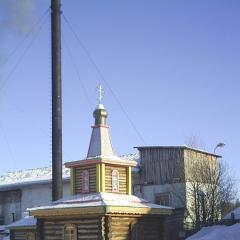HCl Zn ion equation. HCl Zn, OSR reaction equation, abbreviated-ion equation
It's time to move on. As we already know, the complete ion equation needs "cleaning". It is necessary to remove those particles that are present in the right and in the left parts of the equation. These particles are sometimes called "ion observers"; They do not participate in the reaction.
In principle, nothing complicated in this part. It is only necessary to be attentive and to realize that in some cases the full and brief equations may coincide (more - see example 9).
Example 5.. Make a complete and short ion equations describing the interaction of silicic acid and potassium hydroxide in an aqueous solution.
Decision. Let's start naturally with a molecular equation:
H 2 SiO 3 + 2KOH \u003d K 2 SiO 3 + 2H 2 O.
Silicon acid is one of the rare examples of insoluble acids; We write in molecular form. KOH and K 2 SiO 3 we write in ion form. H 2 O, naturally, written in a molecular form:
H 2 SiO 3 + 2K +. + 2OH - \u003d 2K +. + SiO 3 2- + 2H 2 O.
We see that potassium ions do not change during the reaction. These particles do not participate in the process, we must remove them from the equation. We get a desired brief ion equation:
H 2 SiO 3 + 2OH - \u003d SiO 3 2- + 2H 2 O.
As you can see, the process is reduced to the interaction of silicic acid with OH ions. Potassium ions in this case do not play any role: we could replace the sodium hydroxide or cesium hydroxide, while the same process would take place in the reaction flask.
Example 6.. Copper oxide (II) was dissolved in sulfuric acid. Write complete and brief ionic equations of this reaction.
Decision. The main oxides react with acids with the formation of salt and water:
H 2 SO 4 + CuO \u003d Cuso 4 + H 2 O.
The corresponding ion equations are shown below. I think comment on anything in this case is too.
2H + +. SO 4 2- + Cuo \u003d Cu 2+ + SO 4 2- + H 2 O
2H + + Cuo \u003d Cu 2+ + H 2 O
Example 7.. With the help of ion equations, describe the interaction of zinc with hydrochloric acid.
Decision. Metals standing in a row of voltage to the left of hydrogen react with acids with hydrogen release (specific properties of oxidant acids We are not discussing now):
Zn + 2HCl \u003d ZnCl 2 + H 2.
The full ion equation is recorded without difficulty:
Zn + 2H + + 2CL - \u003d Zn 2+ + 2CL - + H 2.
Unfortunately, when switching to a brief equation in the tasks of this type, schoolchildren often make mistakes. For example, zinc is removed from two parts of the equation. This is a rough mistake! In the left side there is a simple substance, uncharged zinc atoms. In the right part, we see zinc ions. These are completely different objects! There are also more fantastic options. For example, H + ions are shred in the left side, and in the right - H 2 molecules. Motivated by the fact that both is hydrogen. But then, following this logic, it is possible, for example, to assume that H 2, HCOH and CH 4 is "the same thing", since in all these substances contains hydrogen. See, to what absurd you can walk!
Naturally, in this example we can (and should!) Erase only chlorine ions. We get the final answer:
Zn + 2h + \u003d zn 2+ + h 2.
In contrast to all disassembled examples, this reaction is redox (during this process there is a change in oxidation degrees). For us, however, it is completely non-procurement: the overall algorithm for writing ion equations continues to work here.
Example 8.. Copper placed in aqueous solution of silver nitrate. Describe the processes occurring in solution.
Decision. More active metals (left to the left in a row of stresses) are abandoned less active of solutions of their salts. Copper is located in a row of voltage to the left of silver, therefore, displaces AG from salt solution:
Cu + 2AGNO 3 \u003d CU (NO 3) 2 + 2AG ↓.
Full and brief ion equations are shown below:
Cu 0 + 2Ag + + 2NO 3 - \u003d Cu 2+ + 2NO 3 - + 2AG ↓ 0,
Cu 0 + 2Ag + \u003d Cu 2+ + 2Ag ↓ 0.
Example 9.. Write ionic equations that describe the interaction of aqueous solutions of barium and sulfuric acid hydroxide.
Decision. We are talking about a well-known neutralization reaction, the molecular equation is recorded without difficulty:
Ba (OH) 2 + H 2 SO 4 \u003d Baso 4 ↓ + 2H 2 O.
Full ion equation:
Ba 2+ + 2OH - + 2H + + SO 4 2- \u003d Baso 4 ↓ + 2H 2 O.
It's time to make a brief equation, and here it turns out an interesting detail: cut, actually nothing. We do not observe the same particles in the right and left parts of the equation. What to do? Search for a mistake? No, no error here is not. The situation of is atypical to us, but quite admissible. There are no observer ions; All particles are involved in the reaction: when connecting the barium and sulfate ions, the barium sulfate precipitate is formed, and with the interaction of H + and OH ions - - weak electrolyte (water).
"But, let me!" - Exclaim you. - "How do we make a brief ion equation?"
In no way! You can say that a brief equation coincides with complete, you can rewrite the previous equation again, but the point of the reaction will not change. Let's hope that the compilers of the EEM options will get rid of you from such "slippery" questions, but, in principle, you should be prepared for any embodiment of events.
It's time to start working yourself. I suggest you to perform the following tasks:
Exercise 6.. Make molecular and ionic equations (full and brief) of the following reactions:
- BA (OH) 2 + HNO 3 \u003d
- Fe + HBr \u003d
- Zn + Cuso 4 \u003d
- SO 2 + KOH \u003d
How to solve task 31 on the exam in chemistry
In principle, the algorithm for solving this task we have already disassembled. The only problem is that the task is formulated several ... unusual. You will be offered a list of several substances. You will need to choose two compounds, between which the reaction is possible, to make molecular and ionic equations. For example, the task may be formulated as follows:
Example 10.. At your disposal there are aqueous solutions of sodium hydroxide, barium hydroxide, potassium sulfate, sodium chloride and potassium nitrate. Choose two substances that can react with each other; Write a molecular reaction equation, as well as full and short ion equations.
Decision. Remembering the properties of the basic classes of inorganic compounds, we conclude that the only possible reaction is the interaction of aqueous solutions of barium hydroxide and potassium sulfate:
Ba (OH) 2 + K 2 SO 4 \u003d Baso 4 ↓ + 2KOH.
Full ion equation:
Ba 2+ +. 2OH - + 2K +. + SO 4 2- \u003d Baso 4 ↓ + 2K +. + 2OH -.
Brief ion equation:
Ba 2+ + SO 4 2- \u003d Baso 4 ↓.
By the way, pay attention to an interesting point: brief ion equations turned out to be identical in this example and in Example 1 from the first part of this article. At first glance, it seems strange: completely different substances react, and the result is the same. In fact, nothing strange here is not: ionic equations help see the essence of the reaction that can be hidden under different shells.
And one moment. Let's try to take other substances from the proposed list and make ion equations. Well, for example, consider the interaction of potassium nitrate and sodium chloride. We write the molecular equation:
KNO 3 + NaCl \u003d Nano 3 + KCl.
While everything looks fairly plausible, and we turn to the full ion equation:
K + + NO 3 - + Na + + Cl - \u003d Na + + NO 3 - + K + + Cl -.
We begin to clean up too much and detect an unpleasant detail: everything in this equation is "superfluous." All particles present in the left side, we find both right. What does this mean? Is it possible? Yes, perhaps simply no reaction occurs in this case; Particles originally present in the solution will remain in it. No reaction!
You see, in the molecular equation, we calmly wrote nonsense, but it was not possible to "deceive" a brief ion equation. This is the very case when the formulas turn out to be smarter than us! Remember: If, when writing a brief ion equation, you come to the need to remove all substances, this means that either you are mistaken and trying to "cut" something superfluous or this reaction is generally impossible.
Example 11.. Sodium carbonate, potassium sulfate, cesium bromide, hydrochloric acid, sodium nitrate. From the proposed list, select two substances that are able to react with each other, write the molecular equation of reaction, as well as complete and short ion equations.
Decision. The list contains 4 salts and one acid. Salts are capable of reacting with each other only if the precipitate is formed during the reaction, but none of the listed salts is capable of forming a precipitate in the reaction with another salt from this list (check this fact using the solubility table!) Acid can react with Salt only in the case when the salt is formed by a weaker acid. Sulfur, nitric and bromomic acid can not be ousted by the action of HCl. The only reasonable option is the interaction of hydrochloric acid with sodium carbonate.
Na 2 CO 3 + 2HCl \u003d 2NACL + H 2 O + CO 2
Please note: instead of formula H 2 CO 3, which, in theory, should have been formed during the reaction, we write H 2 O and CO 2. This is correct, because coalic acid is extremely unstable even at room temperature and easily decomposes into water and carbon dioxide.
When recording a complete ion equation, we consider that carbon dioxide is not an electrolyte:
2NA + + CO 3 2- + 2H + 2Cl - \u003d 2NA + + 2Cl - + H 2 O + CO 2.
We remove too much, we obtain a brief ion equation:
CO 3 2- + 2H + \u003d H 2 O + CO 2.
And now experiment a little! Try, as we did in the previous problem, make ionic equations of unfulfilled reactions. Take, for example, sodium carbonate and potassium sulfate or cesium bromide and sodium nitrate. Make sure that the brief ion equation will again be "empty".
- consider another 6 examples of solving the tasks of EGE-31,
- discuss how to make ionic equations in the case of complex oxidation reactions,
- we give examples of ionic equations involving organic compounds,
- we affect the reaction of the ion exchange flowing in the non-aqueous environment.
Zinc (Zn) is a chemical element belonging to a group of alkaline earth metals. In the periodic table of Mendeleev is located at number 30, which means that the charge of the nucleus of the atom, the number of electrons and protons is also equal to 30. Zinc is in the side II group IV period. By the number of the group you can determine the number of atoms that are on its valence or external energy level - respectively, 2.
Zinc as a typical alkaline metal
Zinc is a typical representative of the metals, in normal condition it has a bluish-gray color, easily oxidized in air, acquiring an oxide film on the surface (ZnO).
As a typical amphoter metal zinc interacts with air oxygen: 2ZN + O2 \u003d 2ZNO - no temperature, with the formation of an oxide film. When heated, white powder is formed.
Oxide itself reacts with acids to form salt and water:
2ZNO + 2HCl \u003d ZnCl2 + H2O.
With acid solutions. If zinc ordinary purity, then the HCl Zn reaction equation is below.
Zn + 2HCl \u003d ZnCl2 + H2 is a molecular reaction equation.
Zn (charge 0) + 2H (charge +) + 2Cl (charge -) \u003d Zn (charge +2) + 2Cl (charge -) + 2H (charge 0) - complete Zn HCl ionic reaction equation.
Zn + 2h (+) \u003d Zn (2+) + H2 - S.I. (Abbreviated ionic reaction equation).
Zinc reaction with hydrochloric acid
This HCl Zn reaction equation refers to the type of redox. This can be proved by the fact that Zn and H2 during the reaction changed the charge, the qualitative manifestation of the reaction was observed, and the presence of the oxidizing agent and the reducing agent was observed.

In this case, H2 is an oxidizing agent, since with. about. The hydrogen before the reaction was "+", and after it became "0". He participated in the recovery process, giving 2 electrons.
Zn is a reducing agent, it is involved in oxidation, taking 2 electrons, increasing C.O. (degree of oxidation).
Also this is a reaction of substitution. In the course of it, 2 substances were involved, simple Zn and complex - HCl. As a result of the reaction, 2 new substances were formed, as well as one simple - H2 and one complex - ZnCl2. Since Zn is located in a row of metal activity to H2, he pushed him out of the substance that reacted with it.
Zinc (Zn) is a chemical element belonging to a group of alkaline earth metals. In the periodic table of Mendeleev is located at number 30, which means that the charge of the nucleus of the atom, the number of electrons and protons is also equal to 30. Zinc is in the side II group IV period. By the number of the group you can determine the number of atoms that are on its valence or external energy level - respectively, 2.
Zinc as a typical alkaline metal
Zinc is a typical representative of the metals, in normal condition it has a bluish-gray color, easily oxidized in air, acquiring an oxide film on the surface (ZnO).
As a typical amphoter metal zinc interacts with air oxygen: 2ZN + O2 \u003d 2ZNO - no temperature, with the formation of an oxide film. When heated, white powder is formed.
Oxide itself reacts with acids to form salt and water:
2ZNO + 2HCl \u003d ZnCl2 + H2O.
With acid solutions. If zinc ordinary purity, then the HCl Zn reaction equation is below.
Zn + 2HCl \u003d ZnCl2 + H2 is a molecular reaction equation.
Zn (charge 0) + 2H (charge +) + 2Cl (charge -) \u003d Zn (charge +2) + 2Cl (charge -) + 2H (charge 0) - complete Zn HCl ionic reaction equation.
Zn + 2h (+) \u003d Zn (2+) + H2 - S.I. (Abbreviated ionic reaction equation).
Zinc reaction with hydrochloric acid
This HCl Zn reaction equation refers to the type of redox. This can be proved by the fact that Zn and H2 during the reaction changed the charge, the qualitative manifestation of the reaction was observed, and the presence of the oxidizing agent and the reducing agent was observed.

In this case, H2 is an oxidizing agent, since with. about. The hydrogen before the reaction was "+", and after it became "0". He participated in the recovery process, giving 2 electrons.
Zn is a reducing agent, it is involved in oxidation, taking 2 electrons, increasing C.O. (degree of oxidation).
Also this is a reaction of substitution. In the course of it, 2 substances were involved, simple Zn and complex - HCl. As a result of the reaction, 2 new substances were formed, as well as one simple - H2 and one complex - ZnCl2. Since Zn is located in a row of metal activity to H2, he pushed him out of the substance that reacted with it.


